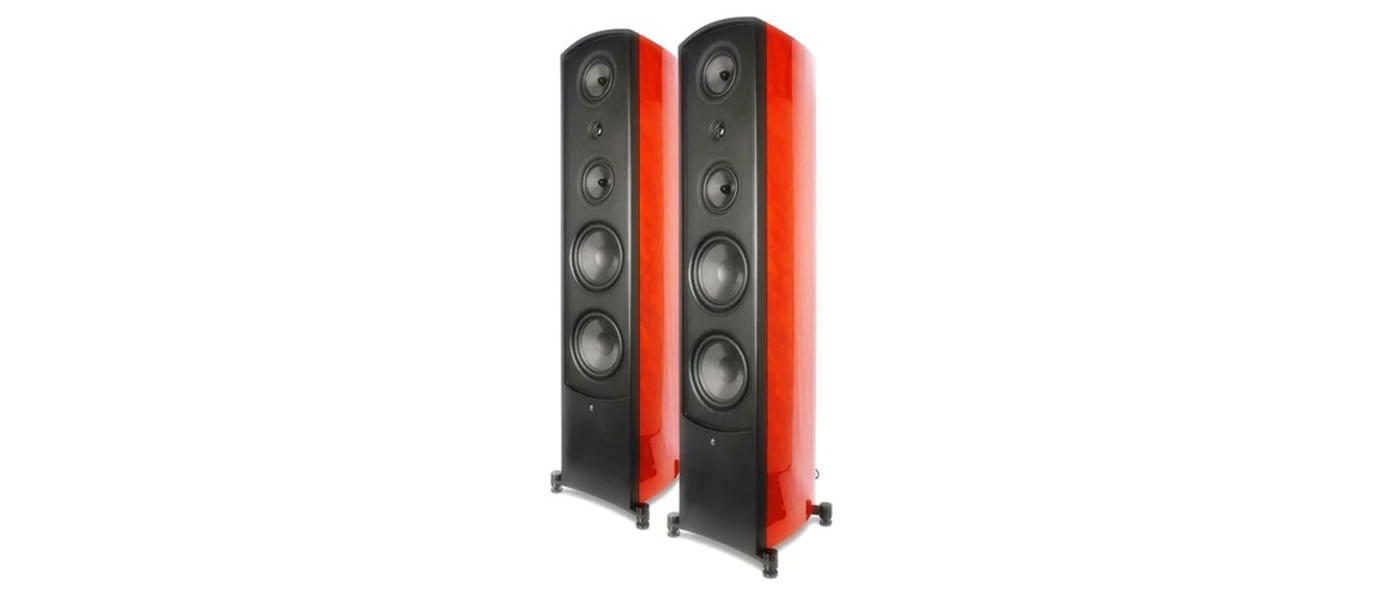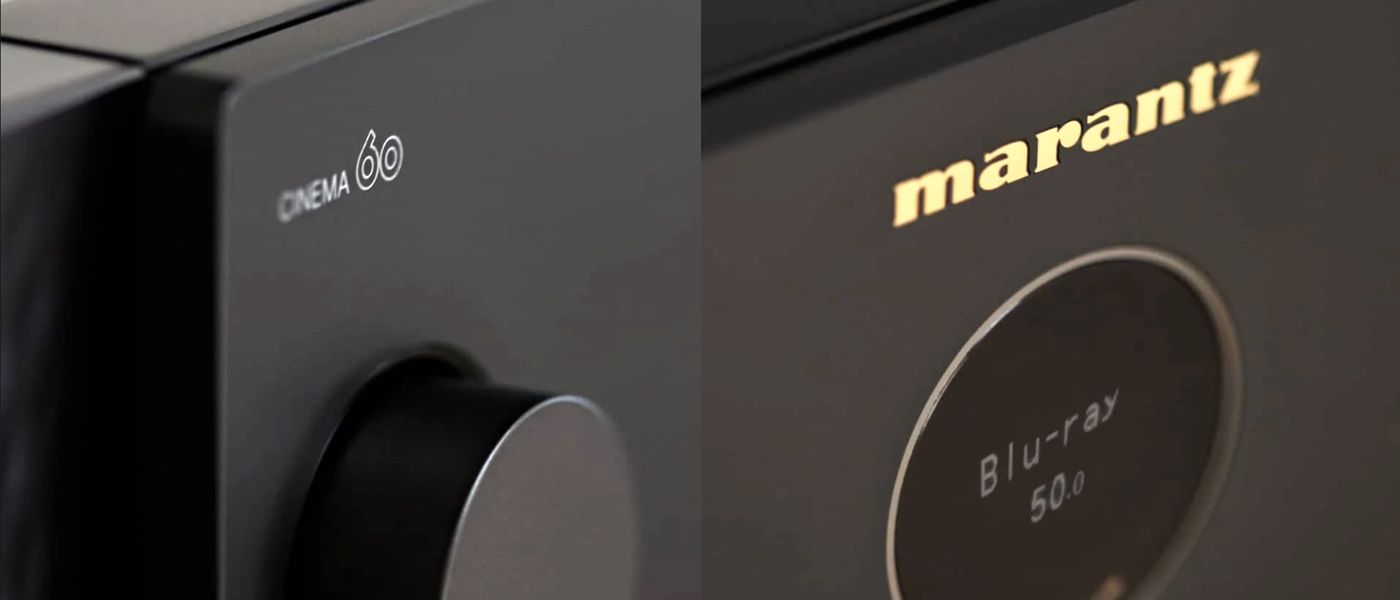There are currently four AV receivers in Marantz’s CINEMA series lineup. From the lowest to the highest MSRP, they are the CINEMA 70 ($1,200), CINEMA 60 ($1,700), CINEMA 50 ($2,500), and CINEMA 40 ($3,500). The higher-priced models are equipped with either more processing and amplification channels or more powerful amplification per channel. The CINEMA 60 reviewed here is the second most affordable model in the CINEMA Series AV receivers lineup to date and is marketed as a 7.2-channel AV receiver. It is sufficiently feature-packed as a typical modern AV receiver and, thus, it should serve well as the center of a home’s AV entertainment system.
Marantz Cinema 60 AV Receiver Highlights
- 7.2-channel AV receiver with 7 x 100 W onboard amplification.
- Dolby Atmos and DTS:X surround processing formats with their virtualization technology.
- 8K Ultra video upscaling and HDMI pass-through feature with HCDP 2.3 support.
- Wireless app and HEOS (Home Entertainment Operating System) control features.
Marantz has been known to make good-quality audio products. It has been especially a strong player in the AV receivers category and has established a great reputation in this particular market segment. AV receiver is a product category that is affected the most by the fast development of audio and video processing technologies and to be strong in this segment, the company has to keep up with these technological developments. In the new CINEMA series AV receivers, Marantz inserts the latest surround and video processing features to keep abreast of the competition in the continually competitive AV receiver markets.
Pricewise, the CINEMA 60 reviewed here is in the mid-upper price range of the AV receiver category at $1,700. Positioned second from the lowest-priced model in the series, which was the CINEMA 70 ($1,200), the CINEMA 60 does not have the current full-blown state-of-the-art surround-format processing channels. However, if your setup only includes 7 speakers with one or two subwoofers, the CINEMA 60 should have all the features needed to handle all the surround processing tasks.
Power Amplifier
Number of Powered Channels:
7
Power Output (8 ohm, 20 Hz – 20 kHz, 0.08% 2ch driven):
100 W
Power Output (6 ohm, 1 kHz, 0.7% 2ch driven):
140 W
Amplifier Topology:
Class A/B
Multichannel Surround Technologies
DTS DTS HD Master, DTS:X, DTS Neural:X, DTS Virtual:
X
Dolby:
Dolby TrueHD, Dolby Atmos, Dolby Atmos Height Virtualization, Dolby Atmos Music, Dolby Surround
Number of Processing Channels:
7.1
Inputs/Outputs
HDMI In / Out:
6 / 2
Analog In:
Fixed Level Out 5 in (including MM Phono) / 0 out
Digital In:
Optical / Coaxial 2 / 2
Multi-Room Out:
analog/digital 1 / 0
Multichannel Preamp Out:
7.2
Subwoofer Out:
2
Number of Speaker Terminals:
7
Multi-Room Speaker Terminal assignable
Front Inputs:
USB-A
AM/FM Tuner:
Yes
HDMI
Total HDMI Inputs / No. Support 8K:
6 / 3
HDCP2.3 support:
Yes
HDMI Outputs Main / Zone:
2 / 0
HDMI Upscaling:
1080P/4K to 8K
Max resolution @ framerate:
8K/60Hz, 4K/120Hz
Audio Return Channel:
ARC, eARC
Video Dynamic Range:
HDR, HLG, Dolby Vision, HDR10+, Dynamic HDR
Other HDMI features:
HDMI Pass-Through in Standby Mode, CEC, Auto Lipsync
Other Features
Acoustics Room Correction:
Audyssey MultEQ XT
Music File Support Lossy formats:
MP3, WMA, AAC
Lossless formats:
FLAC HD 192/24, WAV 192/24, ALAC 192/24, DSD 2.8 MHz / 5.6MHz
Streaming Features:
HEOS, AirPlay
Network Connectivity:
Ethernet, Wi-Fi, Bluetooth
Smart Home Integration:
Alexa, Google Voice Assistant, Apple HomePod
Control Connectivity:
IP Control, RS232 Control, Web Control, App Control (Marantz AVR Remote App, HEOS)
Available Colors:
Black
Power Consumption:
650 W
Standby Consumption:
0.2 W
Network Standby Consumption:
Less than 2.0 W
Dimensions without antenna (W x D x H):
17.4ײ x 13.5ײ x 6.5″
Weight:
24 lbs
MSRP:
$1,700.00
Website:
Company:
SECRETS Tags:
marantz, receiver, avr, cinema60, hdmi, hometheater, marantz reviews, marantz reviews 2023
The CINEMA 60 receiver sports the new two-layer faceplate design similar in style to the one found in the Marantz Model 40n integrated amplifier and CD 60 player that I reviewed recently. The design still retains the classic Marantz faceplate look with its symmetrical knobs/buttons arrangement and the porthole display in the middle. Overall, this layered front panel design looks modern and uncluttered. The two large knobs and most of the push-control buttons are located on the slightly protruding center plate, as are the setup microphone jack and the USB port. The power button and the headphone jack are placed on the left and right recessed outer edges of the front panel. Currently, the finish available is only black, which features a handsome two-tone dark gray and black two-layer front panel appearance.
The CINEMA 60 has 7.1 processing channels and is loaded with features sufficient to be the center of a home entertainment system. Its surround processing can handle the latest multichannel audio formats, including Dolby Atmos with Height Virtualization and DTS:X with its Virtual:X technology. Hence, the CINEMA 60 has the means to provide an immersive surround-sound experience even with its reduced processing channels. It is also equipped with a seven-channel class A/B amplifier onboard, capable of delivering 100 W per channel into 8-ohm loads with 2-channel driven. The CINEMA 60 also includes an Audyssey MultEQ XT auto setup and room calibration system.
When it comes to the video connectivity of the CINEMA 60, Marantz seems to apply the “no look back” philosophy. Embracing the current state-of-the-art HDMI video connections, Marantz leaves out completely the composite and component video inputs from the CINEMA 60 connection inventory. Hence, it does not accommodate the routing of the video signals from older devices that only output video signals through composite or component types of connections. On the audio side, input connections for digital (coax, optical, USB storage access) and analog (stereo line-in and phono) signals are provided. The rear panel also sports 7.2 line-level pre-outs to accommodate external amplification and powered subwoofer(s). The HDMI connection in the CINEMA 60 supports HDCP2.3 and up to 8K 60Hz video format with a pass-through feature in standby mode. It is capable of upscaling HD video to Ultra HD (up to 8K), accommodating high video dynamic range (including HDR10+, and Dolby Vision), and supporting eARC.
As with modern AV receivers these days, the CINEMA 60 supports comprehensive wired (ethernet LAN) and wireless (Bluetooth and Wi-Fi) network connectivity. Once connected to the network, the operation of the unit can be controlled using the Marantz AVR Remote app, which is available on iOS and Android. The CINEMA 60 can also be used to stream music via Airplay or its built-in HEOS (Home Entertainment Operating System) feature, which is accessible through the HEOS app. Besides providing the capability to access your local NAS server, HEOS offers support for popular streaming services such as Pandora, Spotify, iHeart Radio, Deezer, and TIDAL. A pity, however, that HEOS does not support Qobuz, my personal favorite streaming service. The streaming playback of the CINEMA 60 is capable of decoding PCM signals up to 24-bit/192-kHz and DSD signals up to 5.6 MHz (DSD128). Should you prefer, you can also integrate the CINEMA 60 into your smart-home automation system to use its voice control feature through Amazon Alexa, Google Assistant, or Apple Homepod.
The remote control that comes with the CINEMA 60 is slender and sits in hand nicely. The buttons are nicely laid out and clearly labeled. There is a side key to activate the backlit of the remote, which makes it convenient to use in the dark. Alternatively, the unit can be operated/controlled using the Marantz AVR Remote app, which also handily shows the operation status of the unit (the volume level, the sound mode, the input selected, etc.). In fact, during the review, the app was my preferred modus operandi in controlling the CINEMA 60.
The CINEMA 60 can be set up relatively quickly and easily. I connected the HDMI output of the CINEMA 60 to my TV, turned on the receiver, and then followed the clear step-by-step setup guide on my TV. The guide covered the connections of external devices, network setup, and the speaker setup as well as calibration. The HDMI sources connected through the CINEMA 60 were my Xfinity X1 4K TV box and Oppo UDP-203 universal player. The seven speaker terminals of the receiver were connected to the Revel Ultima Studio pair as the two front mains, the Revel C50 as the center channel, and the Revel Concerta M8 speakers as the surrounds. Two SVS SB-3000 subwoofers rounded up the speaker setup used in this review. The sound calibration process using the supplied Audyssey MultEQ XT system (the built-in feature and the calibration microphone) was simple and quick. Just like prior Audyssey calibrations in my system, the result in terms of speaker level calibration and response equalization was quite accurate and only needed slight adjustments here and there to tailor it to my liking.
Secrets Sponsor
I did not have any means to test the 8K video functionality but, other than that, the other video processing features of the CINEMA 60 worked as advertised. I would not hesitate to use the CINEMA 60 as the main video switching hub, as I did not see any discernible differences between the video signals routed through the receiver and the output of the ones directly to my Samsung 75-inch TV. Its video upsampling feature worked flawlessly. I used it to upsample the 1080p video signals from my Xfinity cable box to 4K Ultra HD resolution with satisfactory results, without introducing any noticeable distortions or anomalies.
The essential aspect of an AV receiver is its surround-sound performance, and the CINEMA 60 did not disappoint in this department. With its crisp sonic characteristics, the receiver always decoded surround program materials sent to it effortlessly, creating a sonic envelopment that enhanced my watching experience. The receiver also had no problem in filling my rather large room with sound and it seemed to be able to maintain its composure well even if it was pushed to a louder-than-I-care volume level.
Secrets Sponsor
I enjoyed the surround experience that the CINEMA 60 delivered while watching Spirited (2022) in Dolby Atmos from Apple TV+. This fun Will Ferrell and Ryan Reynolds movie contains a lot of singing, dialogue, background music, and action sequences. The CINEMA 60 handled this complex soundtrack with aplomb, delivering lively and spacious sonic envelopment. The dialogue sounded intelligible even when they were delivered in the middle of the ongoing music as part of a song. The sound effects in the movie sounded crisp and were delivered with convincing textures and impact.


Soundtrack “Wednesday”
The Dolby Digital+ soundtrack of the popular Netflix series Wednesday (2022) was delivered convincingly through the CINEMA 60. I do think that the experience of watching this series would not be the same without a good surround-sound system. The CINEMA 60 really delivered convincingly the rich surround content in the soundtrack of the series, such as the echoic sound in a cave or hall, the rhythmic background music, and the dark forest ambiance sound, which transported me to the devilish-lurking ambiance depicted throughout the movie, allowing me to fully engage in the storyline.

Kandace Springs “Indigo”
That the CINEMA 60 showed prowess in surround applications was to be expected. What I did not expect was how well it performed in stereo music applications. Its phono and headphone performances were decent with their full-sounding and well-balanced sonic characteristics. Its streaming playback through its HEOS feature generally produced pleasant results. Moreover, it played various music file formats I threw at it (DSD, PCM, and MP3) with no issue. Streaming the track Don’t Need The Real Thing by Kandace Springs from her Indigo (2018) album (accessed from Tidal) through the CINEMA 60’s HEOS feature, I was impressed by the tunefulness and liveliness of the presentation. Kandace Springs’ vocals sounded full-bodied, and the receiver did a good job of presenting the rich textures and dynamics in the music. Although the CINEMA 60 might not deliver the smoothness and the image focus in its music presentation as those of the higher-end systems, nevertheless its stereo music performance was no slouch overall.
The Marantz CINEMA 60 looks handsome and more importantly possesses features and performance that will enhance your home entertainment experience.
- Well-built and appealing look
- Includes Dolby Atmos and DTS:X surround virtualization
- Good network connectivity with HEOS feature
- Sufficiently powerful onboard amplifier
- Solid sonic performance in stereo and surround applications
- Backlit remote control
- Controllable via app
The Marantz CINEMA 60 is a strong-performing AV receiver that does all its functions well. Despite the lack of backward compatibility on the video connection side, it has extensive input/output connectivity to accommodate most modern AV needs and to serve as the center for the home entertainment system. The CINEMA 60 is equipped with the latest surround processing capabilities and delivers solid surround-sound performance. More than just surround excellence, the CINEMA 60 also shows prowess as a solid stereo playback device, which makes it a solidly capable single-box entertainment control hub. The CINEMA 60 is priced in the mid-upper range of the receiver category and definitely acts like one. Its features and solid performance squarely justify its asking price.







